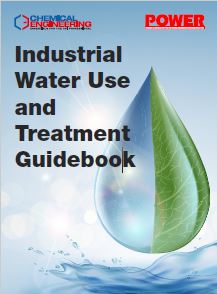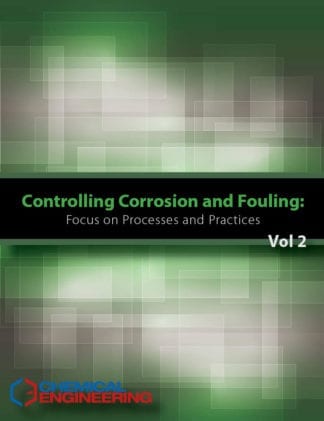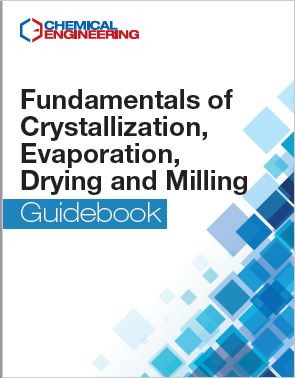Description
Industrial uses of water are many: in cooling towers, condensers and boilers, as process and wash fluids and more. Treatment of water is often needed, to prevent corrosion for example, and for reuse or disposal. With water scarcity as a serious global challenge, efforts to conserve, treat and reuse water, as well as to reclaim water via desalination are leading to new technological advancements.
This collection of articles from Chemical Engineering and POWER magazines presents a timely and informative overview of global efforts on industrialwater-related topics. It includes articles on cooling water, boilers, water conservation, wastewater treatment, some of the latest technological advancements and more.
Delivered in a PDF format. 199 pages.
Articles include:
Section One
Wastewater Sludge Centrifugation Before Drying
The decanter centrifuge is an important piece of equipment for sludge volume reduction prior to thermal drying. Understanding centrifuge operation helps manage drying energy costs
Biological Wastewater Treatment: Maintaining the Needed Microorganism Population
Activated sludge processes are inherently complex. Proper system design, operation and maintenance are essential to adequately break down target organic materials
Cooling Towers: Managing Tighter Water-Discharge Regulations
Tightening regulations for cooling tower water-discharge quality are requiring plant engineers to evaluate enhanced treatment options, sometimes including zero-liquid-discharge systems
Water Takes the Stage at Achema
The emphasis on water management at Achema 2015 indicates the critical nature of water to all industry sectors as the CPI expand and evolve
Cooling Towers: Estimate Evaporation Loss and Makeup Water Requirements
Applying mass and energy balance calculations yields critical operating insight
Superheater Problems in Steam Generators
Knowing the features of a good boiler will prevent problems associated with a poor design
Pressurized Piping: Sampling Steam and Water
Without proper systems, analysis of steam and water chemistry can provide erroneous results — with costly implications
A Primer on Reverse Osmosis Technology
Desalination by reverse osmosis is a key technology for a water-constrained world. Discussed here is its use in industrial water treatment and drinking-water production
Mitigate Corrosion in Condensate-Return Systems
Understanding the chemistry behind corrosion in condensate-return systems can aid in selecting and properly employing the best mitigation technique
Beware of Flow-Accelerated Corrosion
Operators of steam-generating systems should understand flow-accelerated corrosion and the potential problems it can cause
Water-Saving Strategies for the CPI
Water savings at CPI facilities depend on effective water management, smart application of technology and corporate support
The Financial Benefits of Water Treatment
Due to the rising costs of water use and disposal, improved treatment technologies make economic sense
Troubleshooting and Solving a Sour-Water Stripper Problem
A systematic approach identifies problems that prevented a stripper column from achieving trouble-free operation
Understanding Boiler Circulation
Proper arrangement of drum baffling, sizing and location of dowcomers and risers will ensure a good natural-circulation system
Biological Wastewater Treatment: Selecting the Process
Basic steps for developing an industrial-water-treatment process are given, using an example of a difficult-to-biodegrade wastewater stream
Treating Wastewater for Industrial Reuse
Secondary treated wastewater from municipal plants can be a water resource for industry. Important water characteristics and treatment options are discussed
Advantages Gained in Automating Industrial Wastewater Treatment Plants
Process monitoring and automation can improve efficiencies in wastewater treatment systems. A number of parameters well worth monitoring, as well as tips for implementation are described
How To Properly Size A Steam Trap
Don’t confuse the size of a steam-trap’s end connection with the internal discharge orifice for condensate
Modern Water-Treatment Challenges
LNG and other facilities that are expanding due to the shale-gas boom face specific challenges when it comes to ensuring the purity of the inlet and outlet water
Challenges of Drying Sticky Wastewater Sludge
In wastewater-sludge drying and dewatering operations, many issues arise from the sticky properties of the sludge. Here are some insights to address them
Using Sensor Technologies to Optimize Maintenance of Power Plant Water Systems
Nondestructive technologies make the inspection of a plant’s least accessible components relatively easy and deliver results that minimize unexpected failure—and expense.
Desalination Expands, but Energy Challenges Remain
Fearing widespread water scarcity, companies and governments around the world are scoping out desalination technologies to convert seawater to potable water. That’s a rocky path that involves lots of energy and high costs—and potentially high rewards.
Monitoring and Treatment of Closed-Loop Cooling Water Systems
In part because they are closed-loop systems, it can be easy to ignore power plant cooling water systems that support the reliable functioning of everything from stator bars in the generator to critical pump bearings for feed pumps and heat exchangers on air compressors. Proper monitoring and maintenance of these water systems can help you avoid more-costly repairs to the mechanical systems they cool.
Zero-Discharge Pozzolanic Brine Solidification: Another Option for Treating FGD Wastewater
With its expected 30% to 50% lower capital expense and 20% to 40% lower operating cost than traditional zero-discharge systems, a new approach to compliance with the EPA’s effluent limitation guidelines could be attractive.
A Comparison of ELG Compliance Options for Flue Scrubber Wastewater
Meeting the requirements of the Effluent Limitations Guidelines (ELG) means careful consideration of the various options. Both biological treatment and zero liquid discharge (ZLD) approaches have their place, but ZLD may offer more flexibility for the future.
Lowering Cost and Waste in Flue Gas Desulfurization Wastewater Treatment
Many informative articles have been published about options for treating flue gas desulfurization wastewater, but new technologies are rapidly changing the treatment possibilities. This article reviews key economic considerations and introduces an innovative treatment solution that lowers costs and the amount of waste generated.
Reclaimed Water Reduces Stress on Freshwater Supplies
Power generation need not be another source of strain on diminishing freshwater resources. Wellestablished water reclamation technologies are enabling producers to conserve resources—and money.
Using Reclaimed Water in Power Plant Cooling Applications
Using reclaimed water as a makeup supply for cooling tower systems has become a popular option for reducing impacts on local water resources, but it comes with its own challenges because of its unique chemistry. Use of a novel terpolymer can greatly reduce the operational costs involved.
Huaneng Power’s Changxing Station ZLD Project, China
To satisfy China’s more stringent water use and air pollution rules, developers of the new 1.3-GW ultrasupercritical coal-fired Changxing Power Plant used a novel forward osmosis–based brine concentration and water reuse process to treat flue gas desulfurization wastewater for zero liquid discharge (ZLD). It is the world’s first commercial application of this technology.
Prevent Purified Water from Putting a Damper on Your Next Commissioning
When commissioning a new power plant, requirements for purified water can be large—often more than an unfinished plant can supply. When it’s time to bring in outside help, proper planning can help avoid problems and keep budgets under control.
Next-Generation FGD Wastewater Bioreactor Technology Introduced for ELG Compliance
Compliance with one of the latest federal environmental regulations, the Effluent Limitations Guidelines (ELG), can be both costly and complicated. A newly available option offers features and capabilities that may make it a more attractive alternative than conventional approaches.
Section Two- Technology Briefs
A new adsorbent to recover uranium and other heavy metals from wastewater
Bacteria and algae team-up to tackle arsenic-contaminated water
These robust organosilane-based membranes promise benefits
An inexpensive adsorbant for removing silver from wastewater
A self-cleaning electrolytic cell that converts waste streams into disinfectants
Engineered wetlands technology now available for wastewater treatment
Coral enhances the removal of mercury from wastewater
Removing harmful metals from wastewater with crab shells
Improving the efficiency of solar desalination
Organic corrosion inhibitors perform well against oxidizing biocides
Carbon fibers enhance swine wastewater treatment
A new adsorbent for wastewater treatment
Imitating nature leads to a separator for oil droplets
This new water-treatment polymer improves scale control in boilers
A pilot project to capture rainwater for wine production
Remove pollutants from wastewater with this nano-tailored coating
Covered lagoons treat wastewater and make biogas, too
A desalination membrane that is resistant to chlorine
A patent granted for this self-diagnostic technology used in boilers
Reduce energy costs by combining wastewater treatment and desalination
Using algae to clean wastewater
Diamond-based electrodes allow handling of difficult-to-treat wastewaters
This scale inhibitor uses steric dispersion principles
A next-generation membrane bioreactor
Microporous vanadosilicate efficiently removes cesium from wastewater
Municipal water sludge-optimization technology poised for growth
Ceramic membrane filtration to be demonstrated for removing oil from produced water
Phosphorus-free cooling water treatment
A process to treat tight emulsions and intractable oily wastes
An energy-saving bioreactor for wastewater treatment
Nanostructured membrane for water purification
Control biofouling with I2-vapor disinfection
A new carrier for MBBR technology
‘Switchable solvent’ technology is a promising development for advancing forward osmosis
This chemical-free disinfection media requires no power
Turning wastewater treatment into resource recovery
Plasma oxidation disinfects water without the addition of chemicals
This desalination process uses much less energy than RO
Bioelectrochemical system treats wastewater and generates biogas
Continuously cleaned filters for challenging water streams
A new catalyst removes cyanide from wastewater
Converting sewage into fuels




